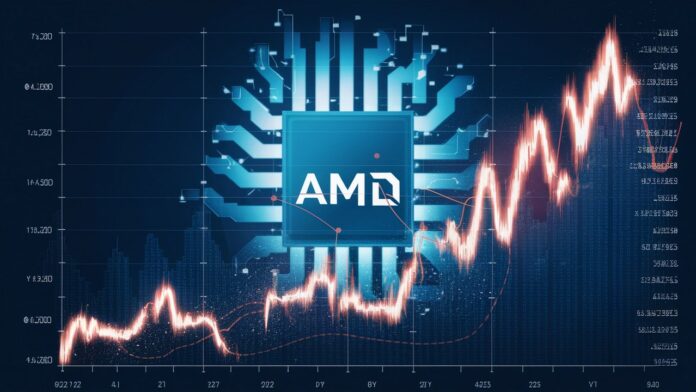Introduction
Advanced Micro Devices (AMD) stands at a critical juncture in 2025. Trading at $113.85 (as of May 28, 2025), the semiconductor giant has seen its stock oscillate between a 52-week low of $76.48 and a high of $187.28 15. Year-to-date, shares have declined 16.41% amid broader semiconductor sector volatility, despite delivering strong quarterly results and positioning itself as a key player in the $500 billion AI accelerator market 28. This article examines the financial performance, valuation metrics, growth catalysts, and risks shaping AMD’s investment thesis.
Financial Performance and Segment Analysis
AMD’s Q1 2025 results revealed robust growth, with revenue climbing 36% year-over-year to $7.44 billion. The Data Center segment was the standout performer, surging 57% YoY to $3.7 billion, driven by soaring demand for EPYC™ CPUs and Instinct™ GPUs 2. Client revenue also impressed, jumping 68% YoY on strong adoption of Ryzen™ “Zen 5” processors. However, challenges persisted in the Gaming segment, where revenue fell 30% YoY due to declining semi-custom sales, and the Embedded segment, which dipped 3% amid mixed end-market demand 2. Profitability metrics showed significant improvement, with non-GAAP operating income leaping 57% YoY to $1.78 billion and diluted EPS reaching $0.96 2. Despite these gains, Q2 guidance disappointed investors due to an $800 million inventory charge related to U.S. export restrictions on AI chips destined for China, which is expected to temporarily compress gross margins to 43% 212.
Valuation Metrics and Market Positioning
AMD’s valuation reflects both optimism about its AI potential and concerns about near-term headwinds. With a market capitalization of $184.6 billion, the stock trades at a premium:
- P/E Ratio (TTM): 83.62 1
- Forward P/E: 28.65 1
- Price/Sales: 6.74 111
- Price/Book: 3.21 1
This valuation significantly exceeds industry peers like Intel (P/S of 1.67) and NVIDIA (P/S of 25.75) 11. Morningstar considers AMD overvalued, assigning a fair value of $120—just 5% above current levels—versus its 188% premium assessment 11. Bulls argue AMD’s PEG ratio of 0.58 signals undervaluation relative to growth potential, while bears highlight vulnerability to earnings misses given lofty multiples 1.
Analyst Sentiment and Price Targets
Wall Street sentiment is decidedly mixed. Recent weeks saw multiple downgrades:
- HSBC upgraded AMD from “Reduce” to “Hold” 714.
- DBS Bank downgraded from “Strong Buy” to “Hold” 14.
- Bernstein slashed its target to $95, citing export control risks 14.
The current consensus price target of $132.58 implies 16.5% upside, though targets range widely from $95 (bear case) to $200 (bull case) 14. Notably, Rosenblatt Securities maintains a $200 target, emphasizing AMD’s AI accelerator roadmap 14. Analysts project Q2 2025 revenue of $7.4 billion (±$300 million), reflecting steady demand despite China-related headwinds 212.
Growth Catalysts and Market Opportunities
The AI infrastructure boom remains AMD Stock Price most compelling catalyst. Hyperscalers like Meta, Microsoft, and Google have committed $64B–$80B annually to AI capex, creating massive demand for advanced chips 812. AMD’s acquisition of ZT Systems enhances its ability to deliver full-stack AI solutions, positioning it to capture share in the data center accelerator market 2. Software advancements are equally critical: ROCm™ now supports Meta’s Llama 4 and Google Gemma 3 models, while collaborations with Core42 and Dell expand its enterprise footprint 2. Beyond AI, the launch of RDNA™ 4 gaming GPUs and Ryzen 9000X3D CPUs could revitalize the gaming segment, while embedded innovations like Versal™ AI Edge SoCs target aerospace and 5G markets 27.

Risks and Challenges
U.S.-China tech tensions pose immediate financial risks. The $800 million Q2 inventory charge stems from tightened export controls, mirroring Nvidia’s $5.5 billion exposure 212. Longer term, these restrictions could crimp AMD’s TAM in China, historically a major market. Competitive intensity is another concern: NVIDIA’s CUDA ecosystem remains entrenched in AI, while Intel’s foundry resurgence threatens CPU share gains 11. Execution risks also loom—Q4 2024 data center revenue of $3.86B missed estimates by $280M, highlighting volatility in chip ramps 8. Finally, AMD’s beta of 2.00 signals extreme sensitivity to market swings, a liability amid recession fears 513.
Technical Analysis and Price Forecasts
Technically, AMD shows resilience above $110 support after plunging from its 2024 high of $187.28 7. Near-term projections suggest a June 2025 surge to $146 (+22.7%), followed by consolidation 10. Long-term models diverge wildly:
- 2025 Year-End: $127 (11% upside) 10
- 2026 Peak: $379 (233% upside) 10
- 2029: $306 (169% upside) 10
These forecasts hinge on AI monetization and margin expansion. Notably, AMD’s 5-year return of 120% already outpaces the S&P 500’s 95%, reflecting embedded growth expectations 1.
Investment Outlook and Strategic Conclusion
AMD Stock Price presents a high-risk, high-reward proposition. Short-term headwinds—China restrictions, inventory charges, and gaming weakness—could pressure shares below $100. However, the company’s four consecutive quarters of accelerating growth, leadership in AI accelerators, and 54% non-GAAP gross margins (ex-inventory charge) underscore its competitive moat 212. Investors should monitor:
- Data Center revenue trajectory in Q3–Q4 2025
- MI300/MI400 GPU adoption by hyperscalers
- Free cash flow trends (currently $3.36B TTM) 1
For patient investors, AMD’s underperformance versus NVIDIA may create an attractive entry point, provided AI revenue scales as projected. The stock suits aggressive growth portfolios with tolerance for volatility.
Frequently Asked Questions
What is AMD’s current stock price and valuation?
As of May 28, 2025, AMD trades at $113.85, with a market cap of $184.6B. It trades at 83× trailing earnings and 6.7× sales—premium multiples reflecting AI growth expectations 111.
Does AMD pay dividends?
No. AMD retains all earnings to fund R&D and acquisitions, contrasting with Intel’s 3–4% dividend yield. Its last ex-dividend date was April 27, 1995 15.
When does AMD report earnings next?
AMD expects to report Q2 2025 results between July 28–August 1, 2025. Analysts project revenue of $7.39B and EPS of $0.59 113.
How have export controls impacted AMD?
Tighter U.S. restrictions triggered an $800M inventory charge for Q2 2025, compressing gross margins to 43%. Long-term, AMD must diversify geographically or secure export licenses 212.
What is the long-term price target for AMD?
Analyst targets range from $95–$200, with a $132.58 average (16.5% upside). Optimistic models project $379 by 2026 if AI adoption accelerates 1014.

